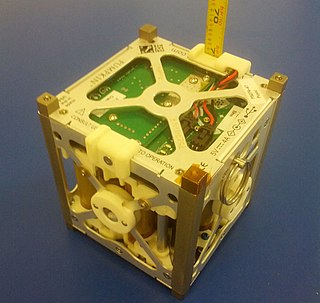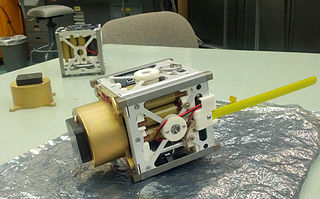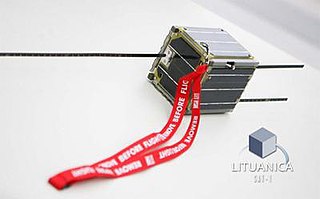Edison Demonstration of Smallsat Networks (EDSN) was a failed (launch failure) CubeSat constellation by NASA Ames, developed as a technology demonstration of satellite networking. The constellation would have consisted of 8 identical satellites. The satellites followed the CubeSat specifications for a 1.5U CubeSat.
EDSN was funded through the Small Spacecraft Technology Program (SSTP). [1] Additionally, NASA Ames has partnered with NASA Marshall, Montana State University, and Santa Clara University. All 8 CubeSats were destroyed during a launch failure of the Super Strypi rocket on November 3, 2015. [2]
The eight identical spacecraft used absolute timing obtained from GPS satellites to maintain a schedule. Each day, one satellite would have acted as a Captain and the rest would have acted as Lieutenants. Each spacecraft was able to act as a Captain, and the role of Captain would have rotated through the constellation each 25-hour period. Lieutenants would only communicate with the Captain, and the Captain would have been responsible for downlinking to an Earth station.
NASA had estimated a 60-day mission lifetime, at which time the satellites would have drifted apart beyond the 100–120 km estimated range of the cross link and would have no longer been able to network.
The constellation was planned for a 500 km altitude. [3]
EDSN was using Triangular Advanced Solar Cells (TASC) for power generation. Intersatellite communications would have been on UHF via a tapespring antenna. Ground communications would have been via an S-band patch antenna. [4] The spacecraft would have used magnetometers and gyroscopes as attitude determination instruments and reaction wheels and torque coils for attitude control.
Cross link would have occurred via the UHF transceiver and on a UHF monopole with an estimated maximum range of 100–120 km. The link would have been initiated when the captain pings the specific Lieutenant's ID. The specified Lieutenant would have then responded with data to be downlinked. Downlink would have occurred on S-Band between the current captain and ground station.
The flight computer was a Samsung Nexus S smartphone. [5]

Teledesic was a company founded in the 1990s to build a commercial broadband satellite internet constellation. Using low-Earth-orbiting satellites small antennas could be used to provide uplinks of as much as 100 Mbit/s and downlinks of up to 720 Mbit/s. The original 1994 proposal was extremely ambitious, costing over 9 billion USD and originally planning 840 active satellites with in-orbit spares at an altitude of 700 km. In 1997, the plan was scaled back to 288 active satellites at 1400 km. Teledesic Corporation changed its name to Teledesic, LLC by pro forma assignment of its license, granted on 26 January 1998.

A CubeSat is a type of miniaturized satellite for space research that is made up of multiple cubic modules of 10 cm × 10 cm × 10 cm size. CubeSats have a mass of no more than 1.33 kilograms (2.9 lb) per unit, and often use commercial off-the-shelf (COTS) components for their electronics and structure. CubeSats are put into orbit by deployers on the International Space Station, or launched as secondary payloads on a launch vehicle. As of August 2021, more than 1600 CubeSats have been launched and more than 90 have been destroyed in launch failures.

A small satellite, miniaturized satellite, or smallsat is a satellite of low mass and size, usually under 1,200 kg (2,600 lb). While all such satellites can be referred to as "small", different classifications are used to categorize them based on mass. Satellites can be built small to reduce the large economic cost of launch vehicles and the costs associated with construction. Miniature satellites, especially in large numbers, may be more useful than fewer, larger ones for some purposes – for example, gathering of scientific data and radio relay. Technical challenges in the construction of small satellites may include the lack of sufficient power storage or of room for a propulsion system.
The Operationally Responsive Space Office is a joint initiative of several agencies within the United States Department of Defense (DoD). The "stand up" of the office took place 21 May 2007 at Kirtland Air Force Base. The first director of the ORS Office was Col. Kevin McLaughlin, who was also dual-hatted as commander of the Space Development and Test Wing located at Kirtland. The ORS Office focuses on providing quick-response tactical space-based capabilities to the warfighter utilizing smaller satellites, such as the Tactical Satellite Program and smaller launch vehicles.
SSETI Express was the first spacecraft to be designed and built by European students and was launched by the European Space Agency. SSETI Express is a small spacecraft, similar in size and shape to a washing machine. On board the student-built spacecraft were three CubeSat picosatellites, extremely small satellites weighing around one kg each. These were deployed one hour and forty minutes after launch. Twenty-one university groups, working from locations spread across Europe and with very different cultural backgrounds, worked together via the internet to jointly create the satellite. The expected lifetime of the mission was planned to be 2 months. SSETI Express encountered an unusually fast mission development: less than 18 months from kick-off in January 2004 to flight-readiness.

RAX-2 is a CubeSat satellite built as a collaboration between SRI International and students at the University of Michigan College of Engineering. It is the second spacecraft in the RAX mission. The RAX-1 mission ended after approximately two months of operation due to a gradual degradation of the solar panels that ultimately resulted in a loss of power. RAX team members applied the lessons learned from RAX-1 to the design of a second flight unit, RAX-2, which performs the same mission concept of RAX-1 with improved bus performance and additional operational modes. Science measurements are enhanced through interactive experiments with high power ionospheric heaters where FAI will be generated on demand.

SPARK, or Spaceborne Payload Assist Rocket - Kauai, also known as Super Strypi, is an American expendable launch system developed by the University of Hawaii, Sandia and Aerojet Rocketdyne. Designed to place miniaturized satellites into low Earth and sun-synchronous orbits, it is a derivative of the Strypi rocket which was developed in the 1960s in support of nuclear weapons testing. SPARK is being developed under the Low Earth Orbiting Nanosatellite Integrated Defense Autonomous System (LEONIDAS) program, funded by the Operationally Responsive Space Office of the United States Department of Defense.
Technology Education Satellite (TechEdSat) is a class of CubeSats built by San Jose State University and University of Idaho students in partnership with NASA's Ames Research Center. These satellites have tested communication technology for smallsats, and have contributed to the development of the Small Payload Quick Return (SPQR) concept.

Alexander, also known as PhoneSat 2.0 Beta or PhoneSat v2a is a technology demonstration satellite operated by NASA's Ames Research Center, which was launched in April 2013. Part of the PhoneSat programme, it was one of the first three PhoneSat spacecraft, and the first Phonesat-2.0 satellite, to be launched.

Graham, also known as PhoneSat 1.0a or PhoneSat v1a was a technology demonstration satellite operated by NASA's Ames Research Center, which was launched in April 2013. Part of the PhoneSat programme, it was one of the first three PhoneSat spacecraft to be launched.

Bell, also known as PhoneSat 1.0b or PhoneSat v1b was a technology demonstration satellite operated by NASA's Ames Research Center, which was launched in April 2013. Part of the PhoneSat programme, it was one of the first three PhoneSat spacecraft to be launched.

PhoneSat is an ongoing NASA project of building nanosatellites using unmodified consumer-grade off-the-shelf smartphones and Arduino platform and launching them into Low Earth Orbit. This project is part of NASA's Small Spacecraft Technology Program and was started in 2009 at NASA Ames Research Center.

LituanicaSAT-1 was one of the first two Lithuanian satellites. It was launched along with the second Cygnus spacecraft and 28 Flock-1 CubeSats aboard an Antares 120 carrier rocket flying from Pad 0B at the Mid-Atlantic Regional Spaceport on Wallops Island to the International Space Station. The launch was scheduled to occur in December 2013, but later was rescheduled to 9 January 2014 and occurred then. The satellite was broadcasting greetings of Lithuanian president, Mrs. Dalia Grybauskaitė. The satellite was deployed from the International Space Station via the NanoRacks CubeSat Deployer on February 28, 2014. All LituanicaSAT-1 subsystems have been turned on, tested and proved to be working properly. The mission is considered a complete success by its team of engineers. The mission ended upon the reentry and disintegration of the satellite on July 28, 2014.

The Nanoracks CubeSat Deployer (NRCSD) is a device to deploy CubeSats into orbit from the International Space Station (ISS).

Mars Cube One was a Mars flyby mission launched on 5 May 2018 alongside NASA's InSight Mars lander mission. It consisted of two nanospacecraft, MarCO-A and MarCO-B, that provided a real-time communications link to Earth for InSight during its entry, descent, and landing (EDL) on 26 November 2018 - when InSight was out of line of sight from the Earth. Both spacecraft were 6U CubeSats, and the mission was a test of new miniaturized communications and navigation technologies. These were the first CubeSats to operate beyond Earth orbit, and aside from telecommunications they also tested CubeSats' endurance in deep space. On 5 February 2019, NASA reported that both the CubeSats had gone silent by 5 January 2019, and are unlikely to be heard from again. In August 2019, the CubeSats were honored for their role in the successful landing of the InSight lander on Mars.

NG-11, previously known as OA-11, is the twelfth flight of the Northrop Grumman robotic resupply spacecraft Cygnus and its eleventh flight to the International Space Station under the Commercial Resupply Services (CRS-1) contract with NASA. The mission launched on 17 April 2019 at 20:46:07 UTC. This is the last mission from the extended CRS-1 contract; follow-up missions are part of the CRS-2 contract. Cygnus NG-11 was also the first mission to load critical hardware onto Cygnus within the last 24 hours prior to launch, a new Antares feature.

Earth Escape Explorer (CU-E3) is a nanosatellite of the 6U CubeSat format that will demonstrate long-distance communications while in heliocentric orbit.
ParkinsonSAT, PSat or Naval Academy OSCAR 84 is a U.S. technology demonstration satellite and an amateur radio satellite for Packet Radio. It was built at the U.S. Naval Academy and was planned as a double satellite. The name ParkinsonSAT was chosen in honor of Bradford Parkinson, the father of the GPS system. After successful launch, the satellite was assigned the OSCAR number 84.
BRICSat-P or OSCAR 83 previously known as PSat-B, is a U.S. technology demonstration satellite and an amateur radio satellite for Packet Radio. BRICSat-P is a low cost 1.5U CubeSat built by the U.S. Naval Academy Satellite Lab in collaboration with George Washington University, that will demonstrate on-orbit operation of a Micro-Cathode Arc Thruster (µCAT) electric propulsion system and carries an amateur communication payload.
CubeSat Particle Aggregation and Collision Experiment (Q-PACE) or Cu-PACE, is a orbital spacecraft mission that will study the early stages of proto-planetary accretion by observing particle dynamical aggregation for several years.
{{cite web}}: CS1 maint: archived copy as title (link)